International Economics: Analyzing US Trade Policy & GDP Impact
VerifiedAdded on 2022/08/19
|7
|1303
|16
Report
AI Summary
This report provides an overview of the United States' trade policy, analyzing its impact on the nation's Gross Domestic Product (GDP). It highlights the US trade deficit, export accounts, and the Trump Administration's trade policies, including renegotiations of NAFTA and engagement with China. The report suggests a shift in focus from exporting military operations to promoting agricultural exports and developing advanced technologies like AI and Machine Learning. It compares current trade policies with proposed changes, estimating their potential contributions to the GDP. The analysis also addresses the importance of incorporating technological advancements in major sectors like healthcare to improve efficiency and reduce costs. The report concludes by emphasizing the need to develop R&D centers to enhance agricultural trade practices and reduce reliance on imports. Desklib provides students with access to a wide range of solved assignments and past papers for similar topics.
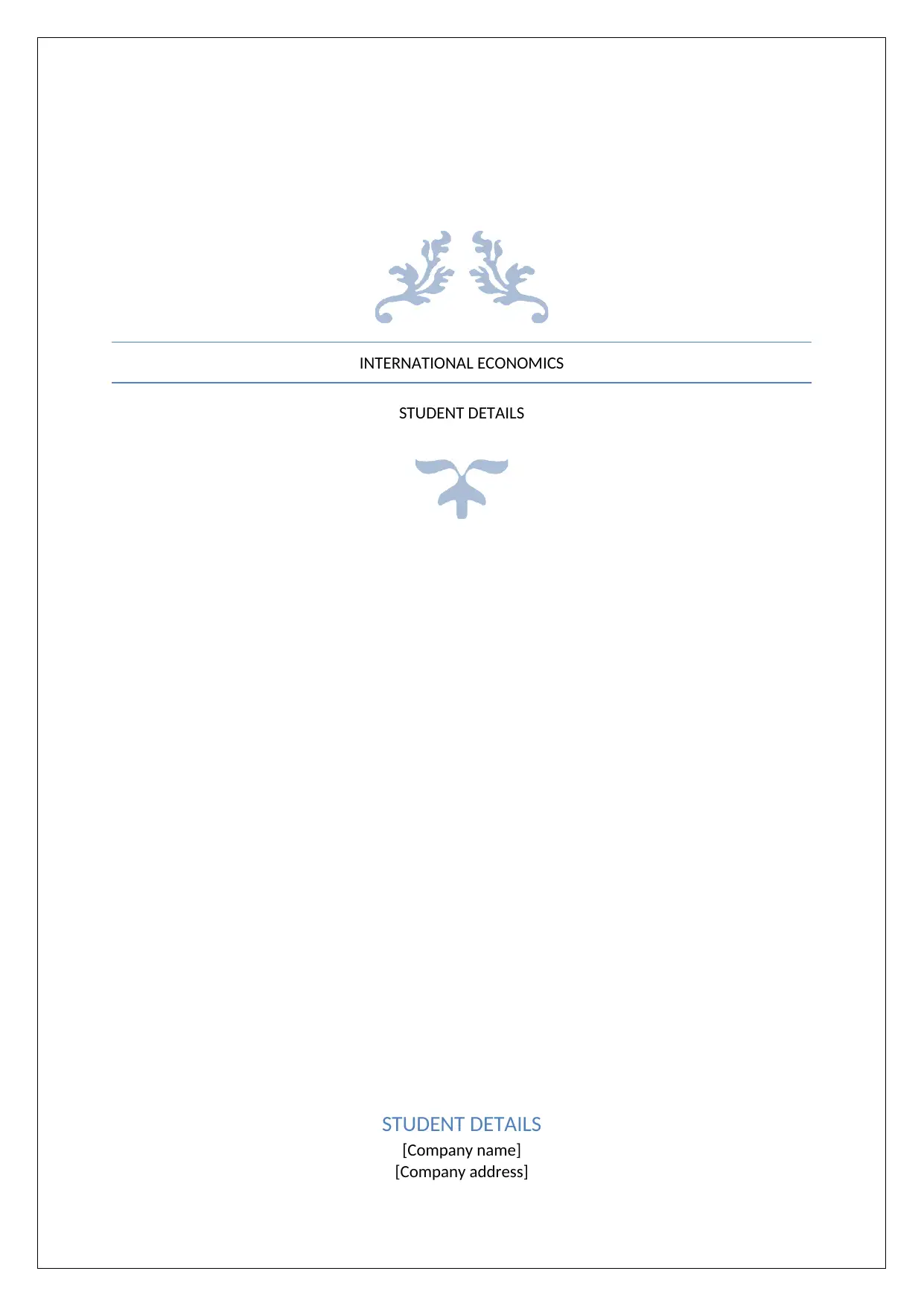
INTERNATIONAL ECONOMICS
STUDENT DETAILS
STUDENT DETAILS
[Company name]
[Company address]
STUDENT DETAILS
STUDENT DETAILS
[Company name]
[Company address]
Paraphrase This Document
Need a fresh take? Get an instant paraphrase of this document with our AI Paraphraser
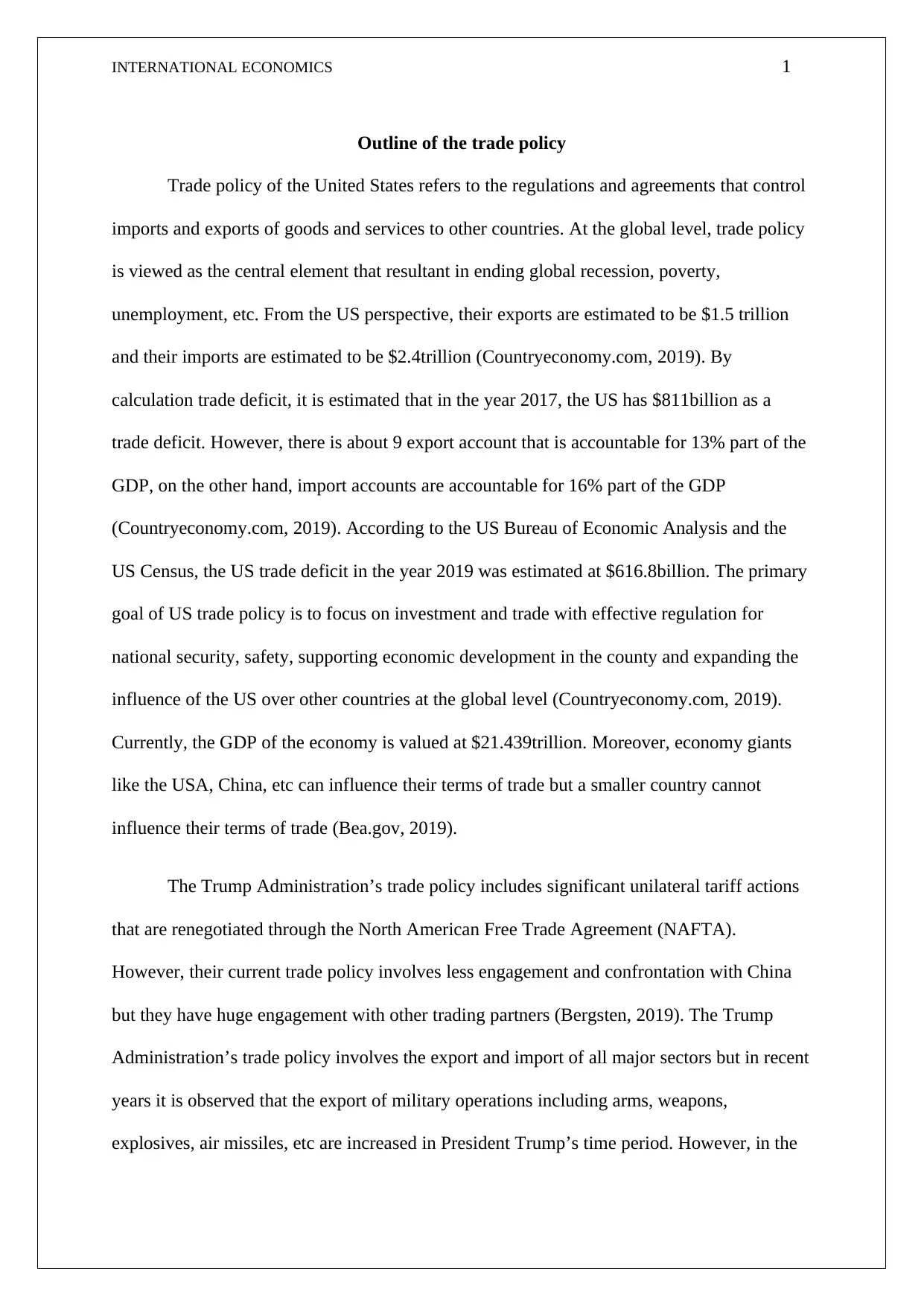
INTERNATIONAL ECONOMICS 1
Outline of the trade policy
Trade policy of the United States refers to the regulations and agreements that control
imports and exports of goods and services to other countries. At the global level, trade policy
is viewed as the central element that resultant in ending global recession, poverty,
unemployment, etc. From the US perspective, their exports are estimated to be $1.5 trillion
and their imports are estimated to be $2.4trillion (Countryeconomy.com, 2019). By
calculation trade deficit, it is estimated that in the year 2017, the US has $811billion as a
trade deficit. However, there is about 9 export account that is accountable for 13% part of the
GDP, on the other hand, import accounts are accountable for 16% part of the GDP
(Countryeconomy.com, 2019). According to the US Bureau of Economic Analysis and the
US Census, the US trade deficit in the year 2019 was estimated at $616.8billion. The primary
goal of US trade policy is to focus on investment and trade with effective regulation for
national security, safety, supporting economic development in the county and expanding the
influence of the US over other countries at the global level (Countryeconomy.com, 2019).
Currently, the GDP of the economy is valued at $21.439trillion. Moreover, economy giants
like the USA, China, etc can influence their terms of trade but a smaller country cannot
influence their terms of trade (Bea.gov, 2019).
The Trump Administration’s trade policy includes significant unilateral tariff actions
that are renegotiated through the North American Free Trade Agreement (NAFTA).
However, their current trade policy involves less engagement and confrontation with China
but they have huge engagement with other trading partners (Bergsten, 2019). The Trump
Administration’s trade policy involves the export and import of all major sectors but in recent
years it is observed that the export of military operations including arms, weapons,
explosives, air missiles, etc are increased in President Trump’s time period. However, in the
Outline of the trade policy
Trade policy of the United States refers to the regulations and agreements that control
imports and exports of goods and services to other countries. At the global level, trade policy
is viewed as the central element that resultant in ending global recession, poverty,
unemployment, etc. From the US perspective, their exports are estimated to be $1.5 trillion
and their imports are estimated to be $2.4trillion (Countryeconomy.com, 2019). By
calculation trade deficit, it is estimated that in the year 2017, the US has $811billion as a
trade deficit. However, there is about 9 export account that is accountable for 13% part of the
GDP, on the other hand, import accounts are accountable for 16% part of the GDP
(Countryeconomy.com, 2019). According to the US Bureau of Economic Analysis and the
US Census, the US trade deficit in the year 2019 was estimated at $616.8billion. The primary
goal of US trade policy is to focus on investment and trade with effective regulation for
national security, safety, supporting economic development in the county and expanding the
influence of the US over other countries at the global level (Countryeconomy.com, 2019).
Currently, the GDP of the economy is valued at $21.439trillion. Moreover, economy giants
like the USA, China, etc can influence their terms of trade but a smaller country cannot
influence their terms of trade (Bea.gov, 2019).
The Trump Administration’s trade policy includes significant unilateral tariff actions
that are renegotiated through the North American Free Trade Agreement (NAFTA).
However, their current trade policy involves less engagement and confrontation with China
but they have huge engagement with other trading partners (Bergsten, 2019). The Trump
Administration’s trade policy involves the export and import of all major sectors but in recent
years it is observed that the export of military operations including arms, weapons,
explosives, air missiles, etc are increased in President Trump’s time period. However, in the
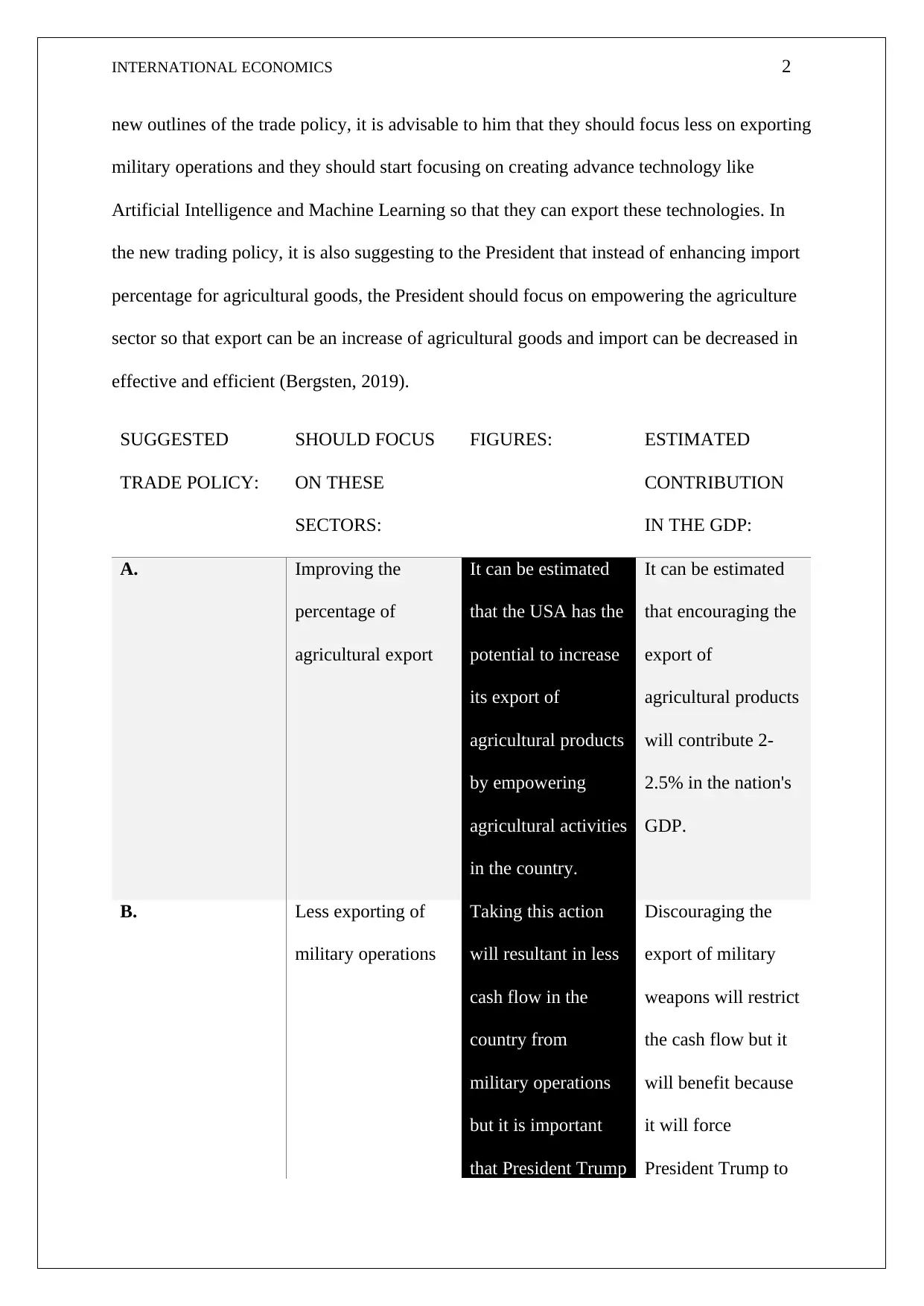
INTERNATIONAL ECONOMICS 2
new outlines of the trade policy, it is advisable to him that they should focus less on exporting
military operations and they should start focusing on creating advance technology like
Artificial Intelligence and Machine Learning so that they can export these technologies. In
the new trading policy, it is also suggesting to the President that instead of enhancing import
percentage for agricultural goods, the President should focus on empowering the agriculture
sector so that export can be an increase of agricultural goods and import can be decreased in
effective and efficient (Bergsten, 2019).
SUGGESTED
TRADE POLICY:
SHOULD FOCUS
ON THESE
SECTORS:
FIGURES: ESTIMATED
CONTRIBUTION
IN THE GDP:
A. Improving the
percentage of
agricultural export
It can be estimated
that the USA has the
potential to increase
its export of
agricultural products
by empowering
agricultural activities
in the country.
It can be estimated
that encouraging the
export of
agricultural products
will contribute 2-
2.5% in the nation's
GDP.
B. Less exporting of
military operations
Taking this action
will resultant in less
cash flow in the
country from
military operations
but it is important
that President Trump
Discouraging the
export of military
weapons will restrict
the cash flow but it
will benefit because
it will force
President Trump to
new outlines of the trade policy, it is advisable to him that they should focus less on exporting
military operations and they should start focusing on creating advance technology like
Artificial Intelligence and Machine Learning so that they can export these technologies. In
the new trading policy, it is also suggesting to the President that instead of enhancing import
percentage for agricultural goods, the President should focus on empowering the agriculture
sector so that export can be an increase of agricultural goods and import can be decreased in
effective and efficient (Bergsten, 2019).
SUGGESTED
TRADE POLICY:
SHOULD FOCUS
ON THESE
SECTORS:
FIGURES: ESTIMATED
CONTRIBUTION
IN THE GDP:
A. Improving the
percentage of
agricultural export
It can be estimated
that the USA has the
potential to increase
its export of
agricultural products
by empowering
agricultural activities
in the country.
It can be estimated
that encouraging the
export of
agricultural products
will contribute 2-
2.5% in the nation's
GDP.
B. Less exporting of
military operations
Taking this action
will resultant in less
cash flow in the
country from
military operations
but it is important
that President Trump
Discouraging the
export of military
weapons will restrict
the cash flow but it
will benefit because
it will force
President Trump to
⊘ This is a preview!⊘
Do you want full access?
Subscribe today to unlock all pages.

Trusted by 1+ million students worldwide
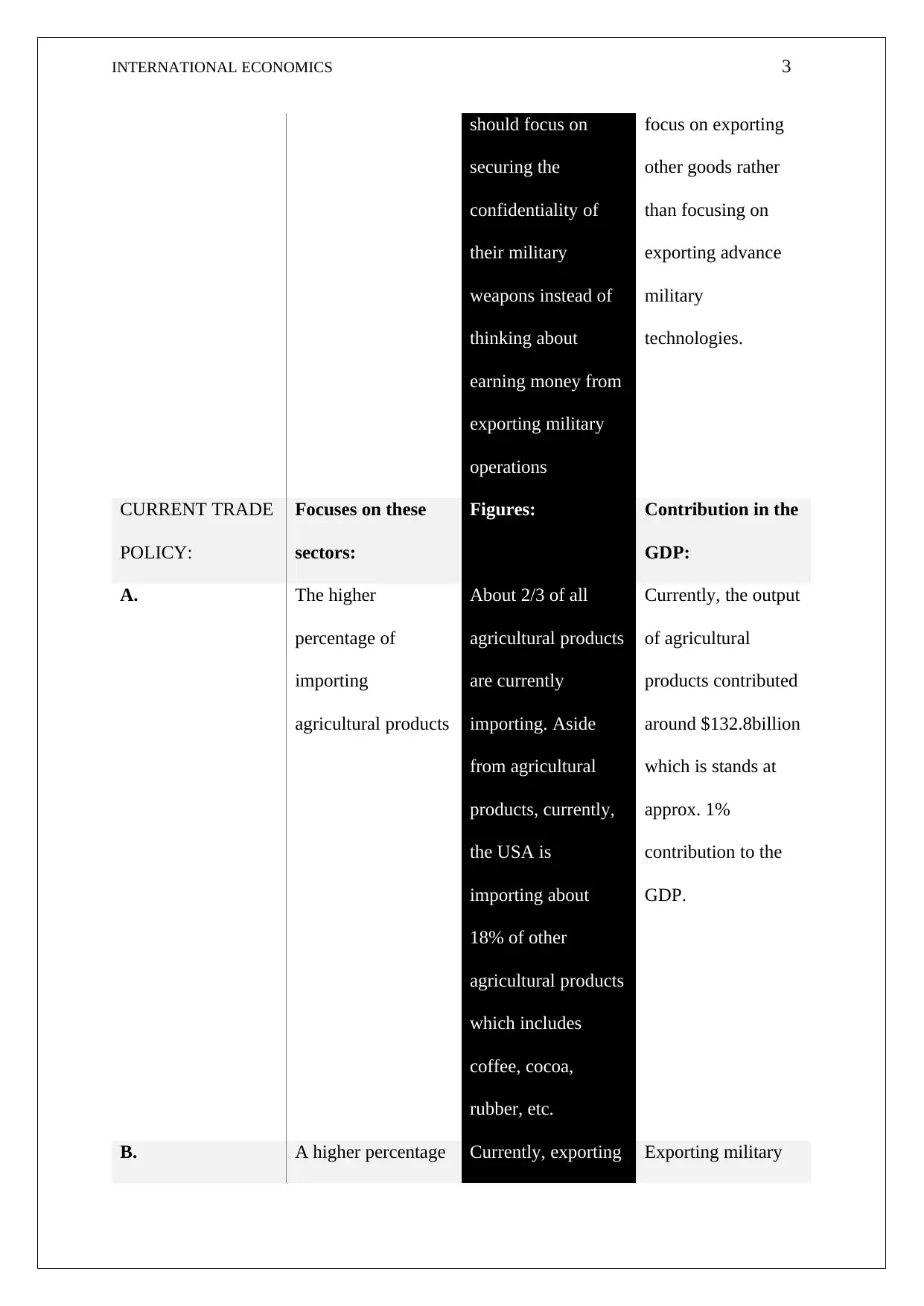
INTERNATIONAL ECONOMICS 3
should focus on
securing the
confidentiality of
their military
weapons instead of
thinking about
earning money from
exporting military
operations
focus on exporting
other goods rather
than focusing on
exporting advance
military
technologies.
CURRENT TRADE
POLICY:
Focuses on these
sectors:
Figures: Contribution in the
GDP:
A. The higher
percentage of
importing
agricultural products
About 2/3 of all
agricultural products
are currently
importing. Aside
from agricultural
products, currently,
the USA is
importing about
18% of other
agricultural products
which includes
coffee, cocoa,
rubber, etc.
Currently, the output
of agricultural
products contributed
around $132.8billion
which is stands at
approx. 1%
contribution to the
GDP.
B. A higher percentage Currently, exporting Exporting military
should focus on
securing the
confidentiality of
their military
weapons instead of
thinking about
earning money from
exporting military
operations
focus on exporting
other goods rather
than focusing on
exporting advance
military
technologies.
CURRENT TRADE
POLICY:
Focuses on these
sectors:
Figures: Contribution in the
GDP:
A. The higher
percentage of
importing
agricultural products
About 2/3 of all
agricultural products
are currently
importing. Aside
from agricultural
products, currently,
the USA is
importing about
18% of other
agricultural products
which includes
coffee, cocoa,
rubber, etc.
Currently, the output
of agricultural
products contributed
around $132.8billion
which is stands at
approx. 1%
contribution to the
GDP.
B. A higher percentage Currently, exporting Exporting military
Paraphrase This Document
Need a fresh take? Get an instant paraphrase of this document with our AI Paraphraser
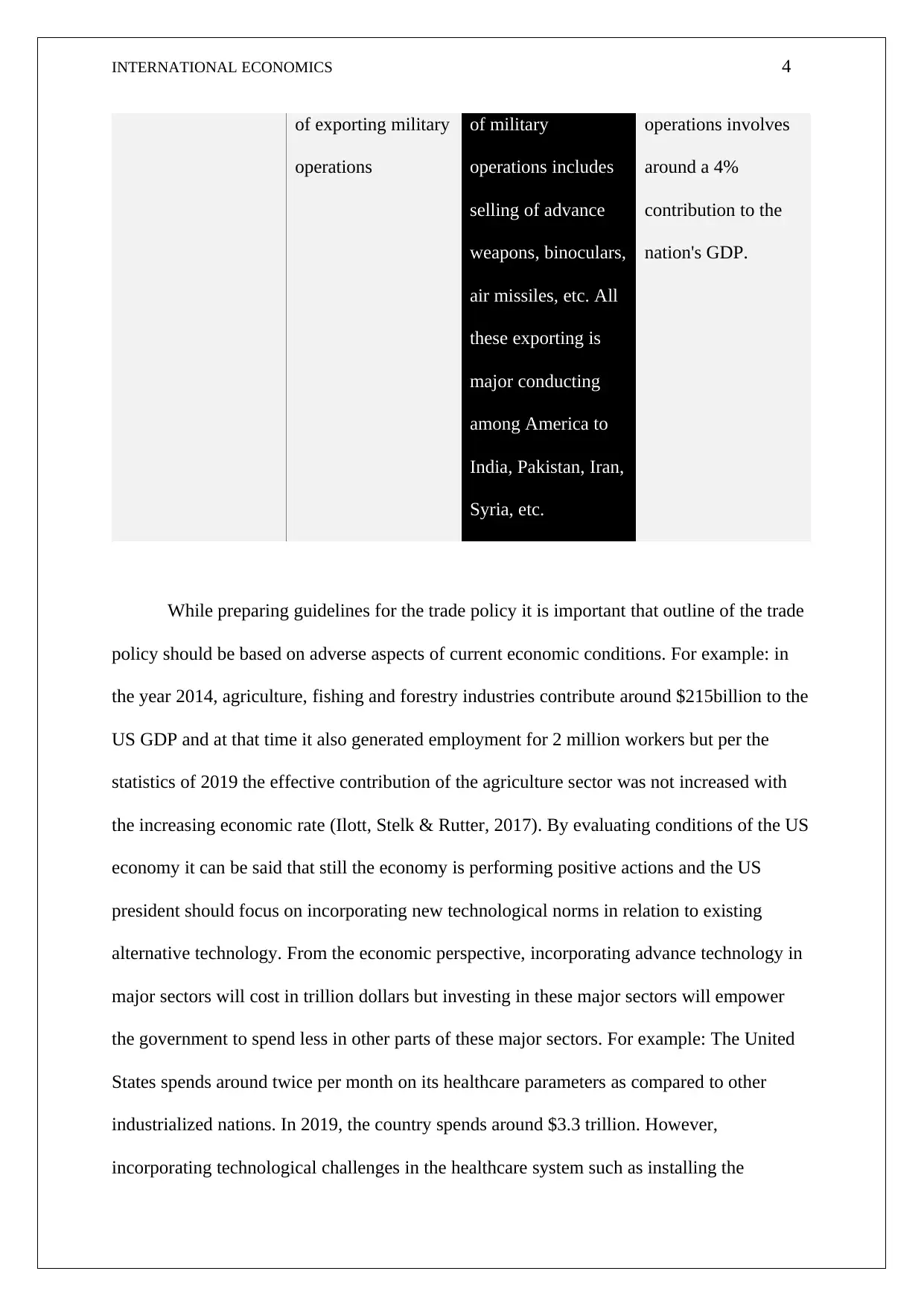
INTERNATIONAL ECONOMICS 4
of exporting military
operations
of military
operations includes
selling of advance
weapons, binoculars,
air missiles, etc. All
these exporting is
major conducting
among America to
India, Pakistan, Iran,
Syria, etc.
operations involves
around a 4%
contribution to the
nation's GDP.
While preparing guidelines for the trade policy it is important that outline of the trade
policy should be based on adverse aspects of current economic conditions. For example: in
the year 2014, agriculture, fishing and forestry industries contribute around $215billion to the
US GDP and at that time it also generated employment for 2 million workers but per the
statistics of 2019 the effective contribution of the agriculture sector was not increased with
the increasing economic rate (Ilott, Stelk & Rutter, 2017). By evaluating conditions of the US
economy it can be said that still the economy is performing positive actions and the US
president should focus on incorporating new technological norms in relation to existing
alternative technology. From the economic perspective, incorporating advance technology in
major sectors will cost in trillion dollars but investing in these major sectors will empower
the government to spend less in other parts of these major sectors. For example: The United
States spends around twice per month on its healthcare parameters as compared to other
industrialized nations. In 2019, the country spends around $3.3 trillion. However,
incorporating technological challenges in the healthcare system such as installing the
of exporting military
operations
of military
operations includes
selling of advance
weapons, binoculars,
air missiles, etc. All
these exporting is
major conducting
among America to
India, Pakistan, Iran,
Syria, etc.
operations involves
around a 4%
contribution to the
nation's GDP.
While preparing guidelines for the trade policy it is important that outline of the trade
policy should be based on adverse aspects of current economic conditions. For example: in
the year 2014, agriculture, fishing and forestry industries contribute around $215billion to the
US GDP and at that time it also generated employment for 2 million workers but per the
statistics of 2019 the effective contribution of the agriculture sector was not increased with
the increasing economic rate (Ilott, Stelk & Rutter, 2017). By evaluating conditions of the US
economy it can be said that still the economy is performing positive actions and the US
president should focus on incorporating new technological norms in relation to existing
alternative technology. From the economic perspective, incorporating advance technology in
major sectors will cost in trillion dollars but investing in these major sectors will empower
the government to spend less in other parts of these major sectors. For example: The United
States spends around twice per month on its healthcare parameters as compared to other
industrialized nations. In 2019, the country spends around $3.3 trillion. However,
incorporating technological challenges in the healthcare system such as installing the
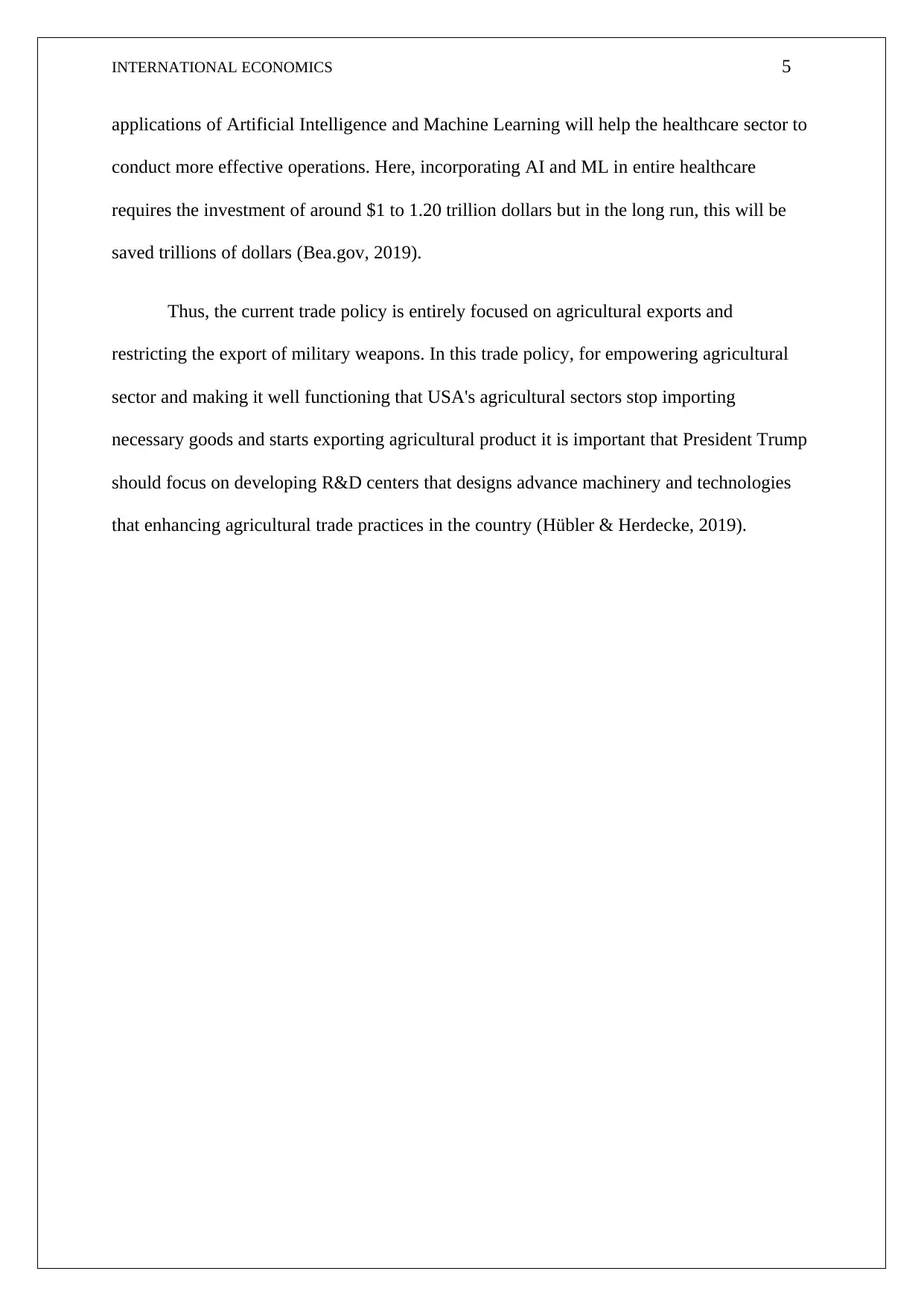
INTERNATIONAL ECONOMICS 5
applications of Artificial Intelligence and Machine Learning will help the healthcare sector to
conduct more effective operations. Here, incorporating AI and ML in entire healthcare
requires the investment of around $1 to 1.20 trillion dollars but in the long run, this will be
saved trillions of dollars (Bea.gov, 2019).
Thus, the current trade policy is entirely focused on agricultural exports and
restricting the export of military weapons. In this trade policy, for empowering agricultural
sector and making it well functioning that USA's agricultural sectors stop importing
necessary goods and starts exporting agricultural product it is important that President Trump
should focus on developing R&D centers that designs advance machinery and technologies
that enhancing agricultural trade practices in the country (Hübler & Herdecke, 2019).
applications of Artificial Intelligence and Machine Learning will help the healthcare sector to
conduct more effective operations. Here, incorporating AI and ML in entire healthcare
requires the investment of around $1 to 1.20 trillion dollars but in the long run, this will be
saved trillions of dollars (Bea.gov, 2019).
Thus, the current trade policy is entirely focused on agricultural exports and
restricting the export of military weapons. In this trade policy, for empowering agricultural
sector and making it well functioning that USA's agricultural sectors stop importing
necessary goods and starts exporting agricultural product it is important that President Trump
should focus on developing R&D centers that designs advance machinery and technologies
that enhancing agricultural trade practices in the country (Hübler & Herdecke, 2019).
⊘ This is a preview!⊘
Do you want full access?
Subscribe today to unlock all pages.

Trusted by 1+ million students worldwide
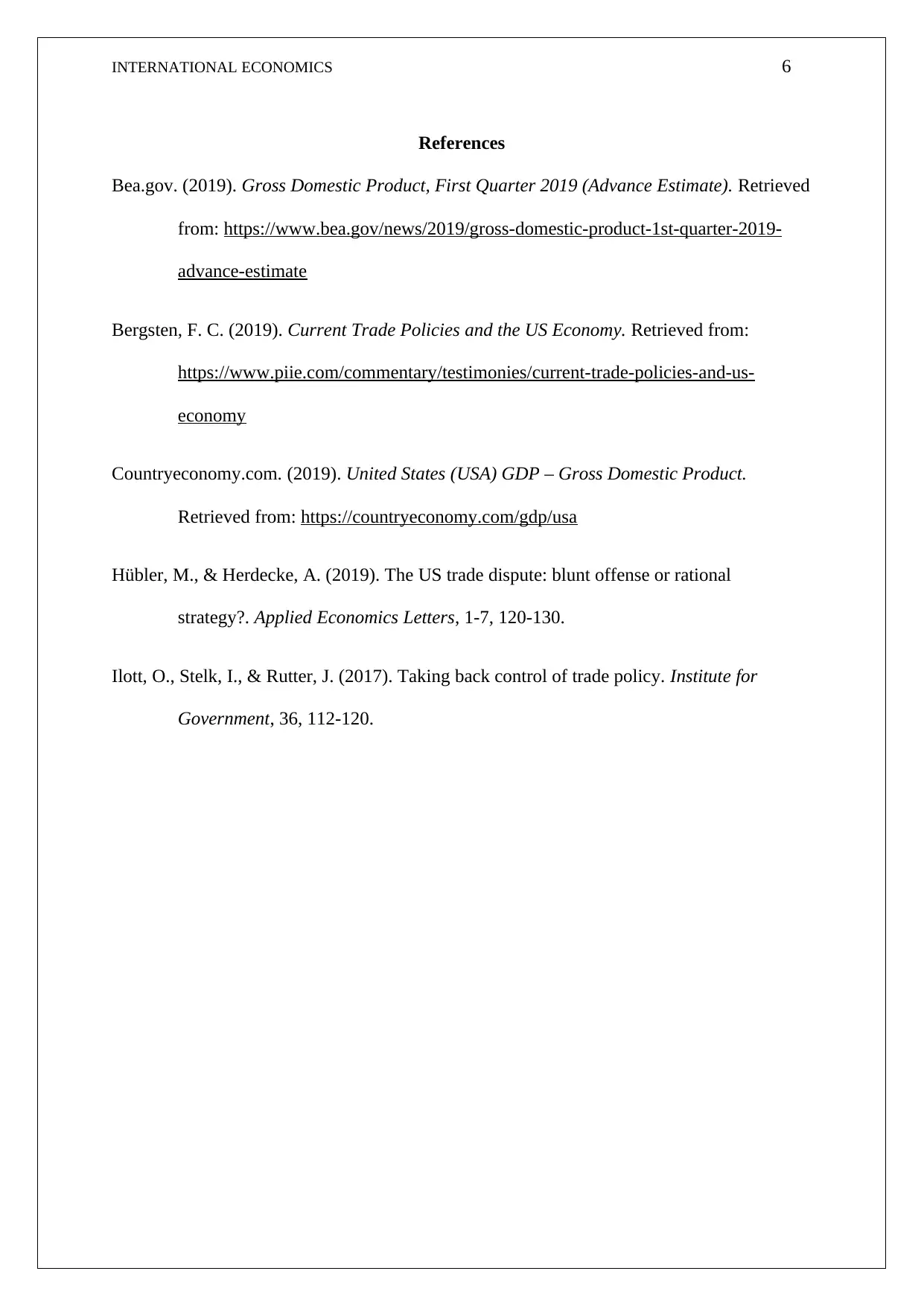
INTERNATIONAL ECONOMICS 6
References
Bea.gov. (2019). Gross Domestic Product, First Quarter 2019 (Advance Estimate). Retrieved
from: https://www.bea.gov/news/2019/gross-domestic-product-1st-quarter-2019-
advance-estimate
Bergsten, F. C. (2019). Current Trade Policies and the US Economy. Retrieved from:
https://www.piie.com/commentary/testimonies/current-trade-policies-and-us-
economy
Countryeconomy.com. (2019). United States (USA) GDP – Gross Domestic Product.
Retrieved from: https://countryeconomy.com/gdp/usa
Hübler, M., & Herdecke, A. (2019). The US trade dispute: blunt offense or rational
strategy?. Applied Economics Letters, 1-7, 120-130.
Ilott, O., Stelk, I., & Rutter, J. (2017). Taking back control of trade policy. Institute for
Government, 36, 112-120.
References
Bea.gov. (2019). Gross Domestic Product, First Quarter 2019 (Advance Estimate). Retrieved
from: https://www.bea.gov/news/2019/gross-domestic-product-1st-quarter-2019-
advance-estimate
Bergsten, F. C. (2019). Current Trade Policies and the US Economy. Retrieved from:
https://www.piie.com/commentary/testimonies/current-trade-policies-and-us-
economy
Countryeconomy.com. (2019). United States (USA) GDP – Gross Domestic Product.
Retrieved from: https://countryeconomy.com/gdp/usa
Hübler, M., & Herdecke, A. (2019). The US trade dispute: blunt offense or rational
strategy?. Applied Economics Letters, 1-7, 120-130.
Ilott, O., Stelk, I., & Rutter, J. (2017). Taking back control of trade policy. Institute for
Government, 36, 112-120.
1 out of 7
Related Documents
Your All-in-One AI-Powered Toolkit for Academic Success.
+13062052269
info@desklib.com
Available 24*7 on WhatsApp / Email
![[object Object]](/_next/static/media/star-bottom.7253800d.svg)
Unlock your academic potential
Copyright © 2020–2025 A2Z Services. All Rights Reserved. Developed and managed by ZUCOL.





